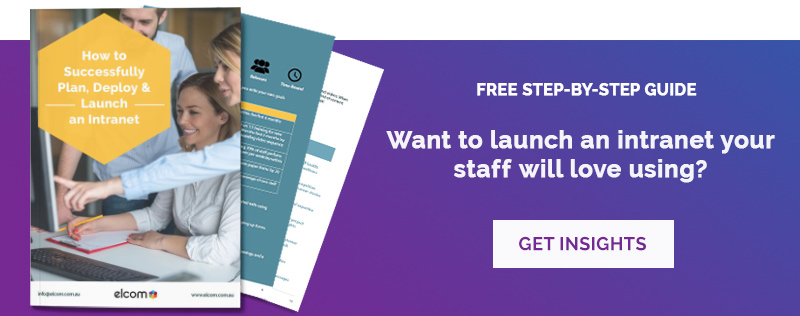It can be tempting to source an intranet service provider or agency straight after getting approval for your new intranet project so it can go live sooner rather than later. As many project managers before you will attest to, effective intranet strategy and intranet redesign project plan can be the difference between an actively engaged community of intranet users and another deserted legacy system.
While this phase is time consuming, it ensures you understand:
- What you want to achieve with your intranet and therefore, how you can measure success.
- What your end users truly want from a new intranet deployment.
- Who is responsible for the intranet project and management after the launch.
- What features are useful for your end users.
Most importantly, it ensures you deliver a great digital employee experience and provide a truly valuable support tool for your staff.
Ready to start putting together your intranet strategy and content ideas? Here are the 5 key steps to get you started.
1. Goals and Purpose
The first step of planning your new intranet is to understand what you want to achieve and how your intranet can truly deliver value by improving business processes. This helps you align your project to your organisation’s goals and show key stakeholders how your intranet will deliver real business value. And after launching, you’ll be able to measure the effectiveness of your intranet based on your goals.
The best goals are SMART - specific, measurable, attainable, relevant and time-bound.
Here are some examples of SMART goal setting to help you write your own goals based on your objectives:
- Increased efficiency: We want to reduce emails sent internally by 25% after 3 months of launching our intranet.
- Increased efficiency: Retire our newsletter, external document management system, brand library and service hubs, within 6 months of launching our intranet (with functionality and information managed and delivered within the one intranet).
- Cost savings: Save $20,000 within a 6 month period, by reducing the need for a contact administration assistant to process paper forms by 20 hours a week.
2. Identify Your End Users

Personas are commonly used by marketing teams to classify the external audience they target. However, they are just as useful for an internal audience. The purpose of personas is to identify common wants, needs and behaviours among groups of your end users.
Why is this important? Here are some of the key insights it can provide:
- Pain points and what features are most useful to them.
- What their goals are and how the intranet can support them.
- Their technology and device preferences.
- What functionality they need vs. what functionality they want (this is very helpful if you plan to a staggered launch approach).
- What intranet content is valuable for them.
Most organisations will need to create 3-5 personas to cover most user types.
3. Establish Governance
Governance involves figuring out who’s in charge of making decisions about your company intranet and what steps are involved in ensuring intranet best practice standards are maintained.
While an intranet may be valuable in the months after launching, if it is not well-enforced by a thorough intranet adoption strategy, the entire system risks becoming an outdated and difficult to use.
For intranet governance to be successful, it must embody several key components:
- Establish policies and decisions about structure and objectives.
- Communicate these decisions in a clear and concise way.
- Decide who will implement intranet governance on an ongoing basis.
The main decisions pertaining to intranet at its outset include:
- What is the best intranet software?
- Who “owns” it?
- How will it be organised/structured?
- Who will manage the intranet?
- Who will manage the intranet content strategy and ongoing optimisation?
- Who will make specific updates?
- How will permissions and user access be managed?
- How will new users be taught how to use the intranet?
- How will user-generated content be vetted and managed?
- What is the goal of the intranet?
- This could be increased collaboration, higher workplace engagement, more effective training, better workplace morale – or all of the above.
Set up a meeting with key intranet stakeholders to discuss governance and goals, assign roles and get your planning underway. During this meeting, you'll also want to move onto the next step - forming your team.
Related resources: [Blog post] Intranet Governance Best Practices
4. Form Your Intranet Team

After you’ve established governance, the next step is to form your intranet project team.
Here are some key roles you’ll need to fill before you build and launch an intranet:
Intranet project manager
Choose someone from your IT or Internal Communications department with suitable skills and experience to manage your intranet launch.
Department representatives
Choose one person from each department to supply content for the intranet and help get their team on-board for a successful launch.
Persona representatives
Nominate one team member for each persona (identified in step 2) who you can refer to for user testing and feedback.
Senior management representative
Choose a member of the executive team to participate in key meetings and decisions, and ensure the management team are on-board.
Intranet manager
Select a suitable representative from management and/or HR who is responsible for managing the intranet team and key decisions after it’s launched.
Intranet administrator(s)
Find active intranet users who can monitor the platform to ensure that content and discussions fit within the guidelines.
Once you’ve got your team, you’ll be able to collaborate on important decisions, such as selecting a new solution and choosing features. For example, you could ask them for feedback on the design or to test your prototype before deployment. And just as importantly, they can be an effective evangelist to help promote the benefits of your intranet before launch and improve your adoption rates across your organisation.
5. Choose your Intranet Features
The next step of planning is to decide on the intranet software features you want. This is where all the persona research you conducted earlier will help significantly.
There is no point implementing costly functionality if it doesn’t meet the needs of your users and creates an unnecessary cluttered intranet design.
Related resources: [Blog post] Best Practice Intranet Design Principles
Common features found in a good intranet include:
- Intuitive publishing
- Security permissions
- Document management
- Forms and workflows
- Dynamic widgets
- Enterprise social networking tools
- Enterprise search
- Mobile responsive design
- Personalised interface
- Two-factor authentication
You may also want your intranet to integrate with existing systems such as your CRM and identity management provider, as well as implement custom functionality that is unique to your organisation. This will help you set up your intranet as the foundation of your digital workplace.
During this stage, you need to weigh up the cost vs the benefit of implementing any third-party integrations and customisation.
Related resources: [Blog post] 10 Company Intranet Features That Staff Love
Prioritise the features you’ll need
It’s easy to get analysis paralysis when you’re faced with narrowing down your list of features! So start by thinking about...
- How soon you need to launch - more features will take longer to set up.
- How much you want to invest in the initial build - more features will require a greater investment.
- What your priorities are - consider what will add the most value to your user personas.
Related resources: [Blog post] How to Effectively Evaluate and Choose Intranet Software
Next Steps: Always bring it back to your goals and users
The right features and integrations will depend on your intranet goals, your organisation’s objectives and what your users need.
If in doubt, start with the basics - you can always upgrade your intranet platform down the track and add additional features and integrations based on feedback from your users.
We strongly recommended you read the guide - How to Successfully Plan, Deploy and Launch an Intranet. This comprehensive guide will equip you with best practices and insights to properly plan, deploy and launch your intranet.
